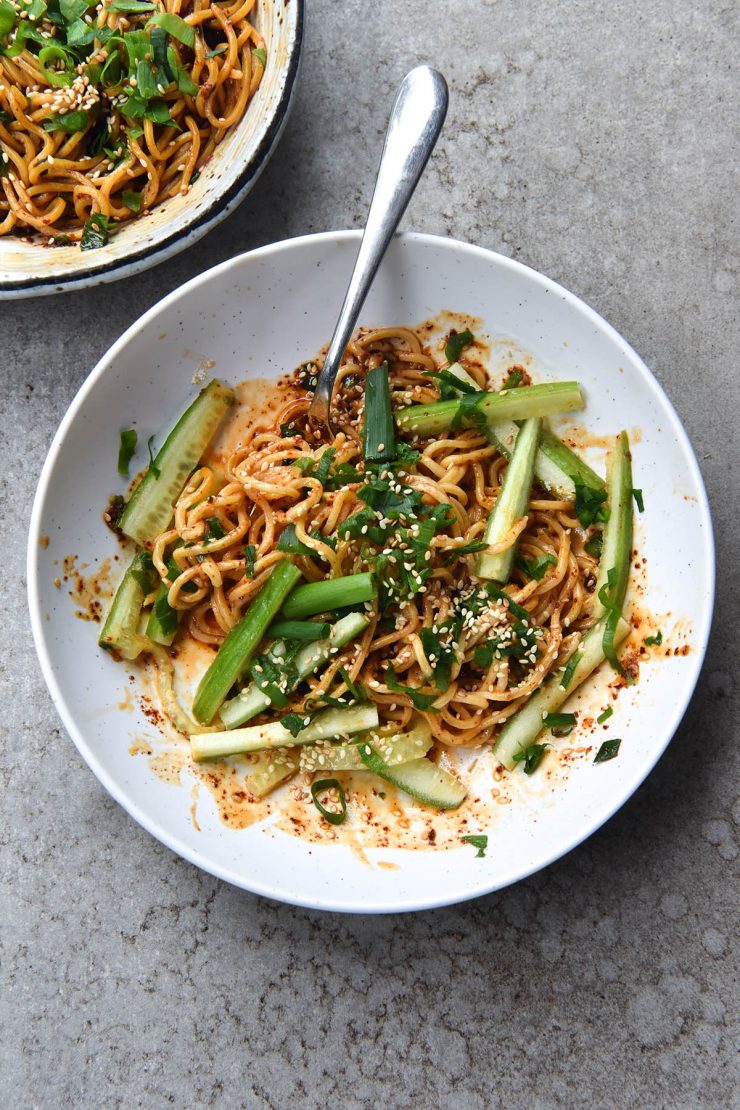
Garlic oil noodles seem to be a mainstay of Instagram and TikTok right now. Not one to miss out, I decided to develop a recipe for FODMAP-friendly chilli oil noodles. Needless to say, these noodles don’t have garlic. What they do have on their side, however, is a delicious, spicy kick and a very speedy cooking time. They also use these delicious, gluten free egg noodles from my cookbook, Intolerance Friendly Kitchen.
FODMAP-friendly chilli oil noodles
These FODMAP-friendly chilli oil noodles are a delicious snack or dinner for one. I’m currently quite into developing single serve recipes, as you might be able to tell from these single serve microwave cinnamon scrolls. As a single gal who cooks for a living, I love the idea of a quick and easy single serve without a family worth of leftovers at the end.
This is a great low FODMAP dinner recipe. It uses gluten free noodles and a FODMAP friendly chilli oil made without onion or garlic. You can add in some peanut butter for a peanut hit, if you like, but these noodles can be made without nuts, as well.

FODMAP notes and substitution options
Interestingly, Korean chilli flakes have a higher FODMAP content than regular chilli flakes. 2 teaspoons contain moderate amounts of fructose. If you have no issues with chilli, go ahead and use 2 teaspoons of Korean chilli flakes. If not, I have some suggestions below on how to cater these FODMAP-friendly chilli oil noodles to every chilli preference.
A gluten free noodle with no high FODMAP flours (like besan) will work here. Make sure you read the labels.
To make these noodles vegan, use a vegan noodle and substitute the honey for maple syrup. To make them sesame free, omit the sesame seeds and sesame oil. Check to ensure no other ingredients contain sesame in case of an allergy.
Needless to say, do not use peanut oil for peanut butter when catering to a peanut allergy. Make sure to check all the labels to ensure everything is nut free if you are.
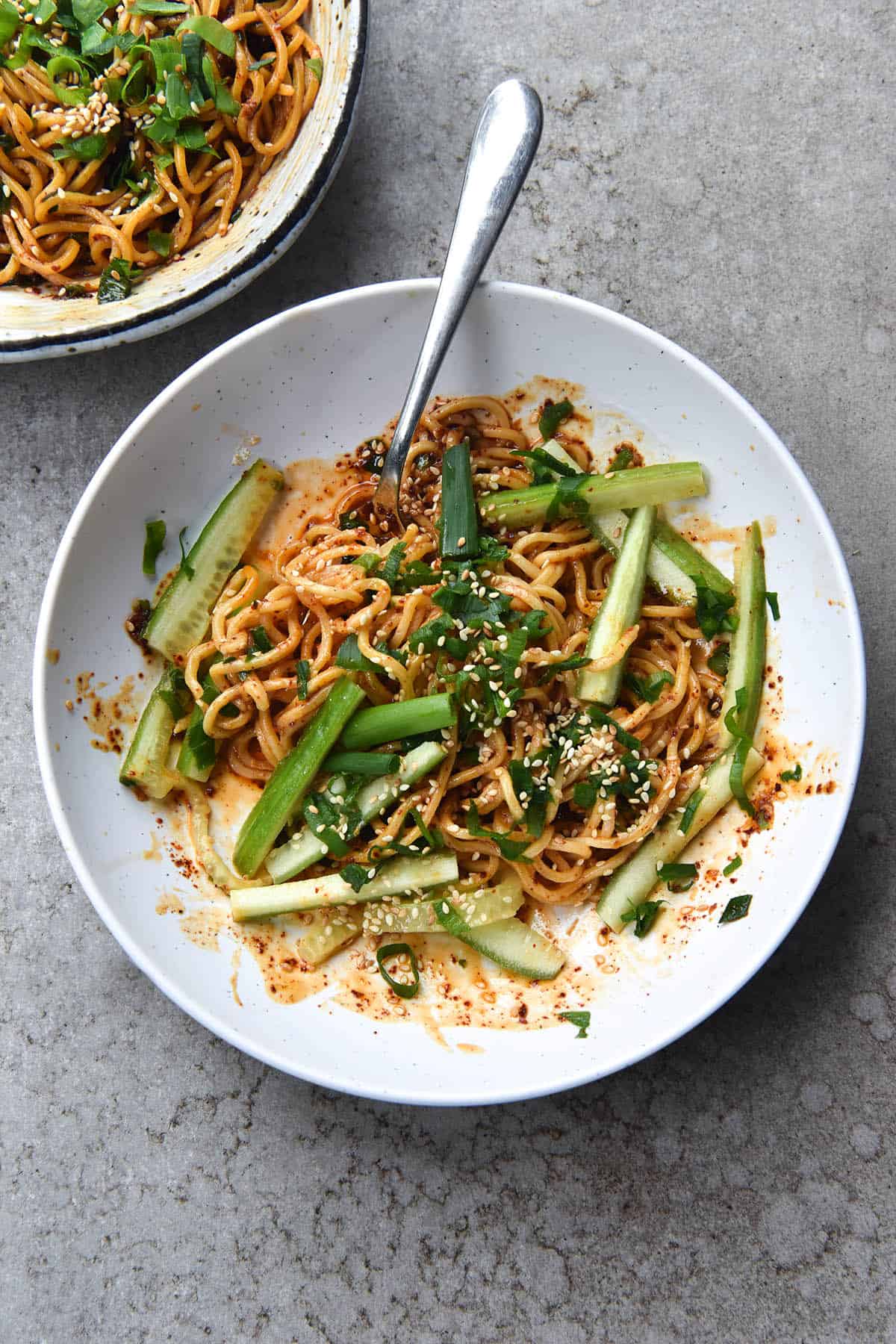
Notes on the FODMAP content of chilli and chilli flakes
I use and love Korean chilli flakes. They are milder than regular flakes, fruitier, and have a lovely bright red colour, even after adding the sizzling oil. I bought a big packet (1kg) when I was at an Asian grocer and they have lasted me over a year, with plenty left. I daresay you could also buy them online.
Interestingly, Korean chilli flakes have a higher FODMAP content than regular chilli flakes. 2 teaspoons contain moderate amounts of fructose. If you have no issues with chilli/fructose, go ahead and use 2 teaspoons of Korean chilli flakes. If not, I have some suggestions below on how to cater these FODMAP-friendly chilli oil noodles to every chilli preference.
Firstly, you can use regular chilli flakes. They are hotter than Korean chilli flakes, so you will need to add according to your taste. You can finish with some paprika for colour if you like – chilli flakes tend to make a muddier brown oil when compared to Korean chilli flakes.
Secondly, you can add 1 teaspoon Korean chilli flakes and a good extra grating of fresh ginger. I love adding ginger to these noodles because I think it adds a dimension that is missing without garlic. Raw ginger also adds a bit of heat, which will help balance out the lack thereof.
Another ingredient I like to add is pepper, whether that is Sichuan or regular. Sichuan has a numbing, spicy quality that is really delicious and unique. If you don’t have Sichuan, regular cracked pepper is great too.

What sort of noodles should I use?
I have used the gluten free egg noodle recipe from my cookbook here. I developed the recipe in response to the fact that there aren’t many gluten free egg noodle options available here in Australia. Noodles have a nostalgic element for me as I used to eat them after school as a kid. I wanted to recreate my favourite snack – noodles with Tamari and toasted sesame oil. I think the noodles in the book really hit that mark for me. You can buy the cookbook here.
I have seen people use regular gluten free spaghetti in place of noodles, too. This is a great, easy option for anybody who can’t eat egg or for a vegan option. I recommend Green Olive Organics spaghetti here in Australia – it’s wholegrain and made with a number of different grains.
Another option is to use the 100% buckwheat flour noodles from my buckwheat e-book. They are vegan, xanthan gum free and use only buckwheat flour, water and salt.

Optional additions for your FODMAP friendly chilli oil noodles
- Some finely sliced cucumber batons are a nice addition of crunch here. They also provide some cooling from the heat of the chilli oil.
- Some pre-cooked (or not) sliced tofu also helps ramp up the protein.
- If you eat eggs, a fried egg on top would also make these FODMAP-friendly chilli oil noodles more of a complete dish.
- I like adding 2-3 teaspoons of smooth, natural peanut butter here. If you can’t have peanuts, tahini also works really well (although I would cap the tahini at 2 teaspoons).
- Steamed Asian greens such as pak choi or bok choi make a great addition. In the same vein, you can throw in any steamed vegetables you like. Keep in mind, though, that you will throw off the balance of sauce to noodle. You might consider making double the sauce and then adding extra as needed to coat everything. Extras can be stored in the fridge to serve with a protein or rice the next day.
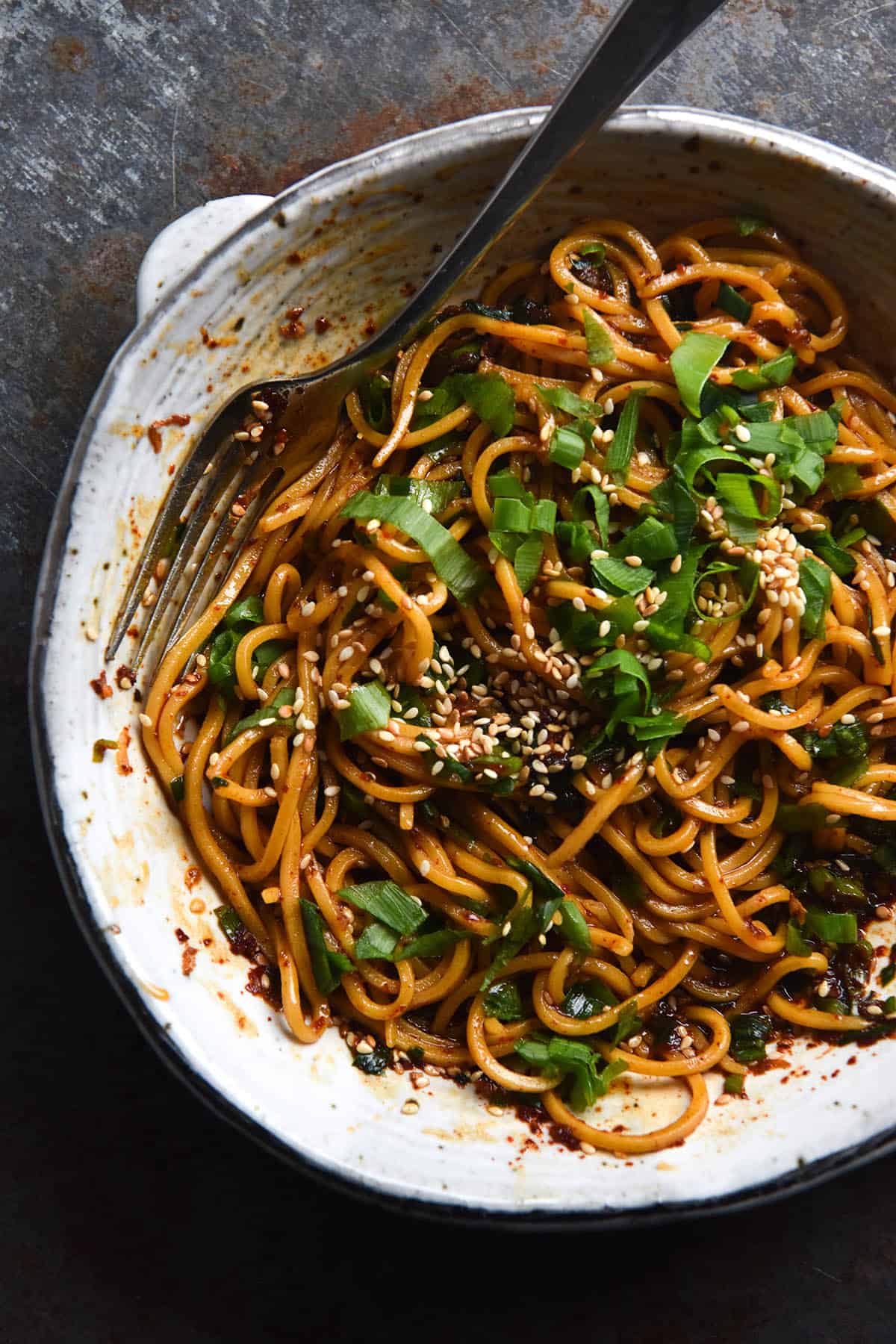
Ingredient notes
Black rice vinegar has a sweet, almost watered down balsamic vinegar taste without as strong of an acidic tang. It’s a lovely ingredient here and lends just a bit of acid without being overbearing. You can use white rice vinegar if you don’t have it, but I recommend adding 1/2 teaspoon at first and building up if you like it more acidic.
For colour, I highly recommend using dark soy sauce. In Australia, Ayam brand makes gluten free dark soy sauce. You also also use Tamari, but your noodles might have a different colour.
Interestingly, their website suggests that dark soy is less salty than regular soy. I was under the impression it was saltier! But a quick Google tells me I have been living a lie. So, if you plan to use Tamari instead of dark soy sauce, use less than the recipe specifies.
Garlic chives are found at Asian grocers. They are related to chives, but have a flat blade leaf and a garlic flavour. I really like using them, but they easily omitted if you don’t live nearby.
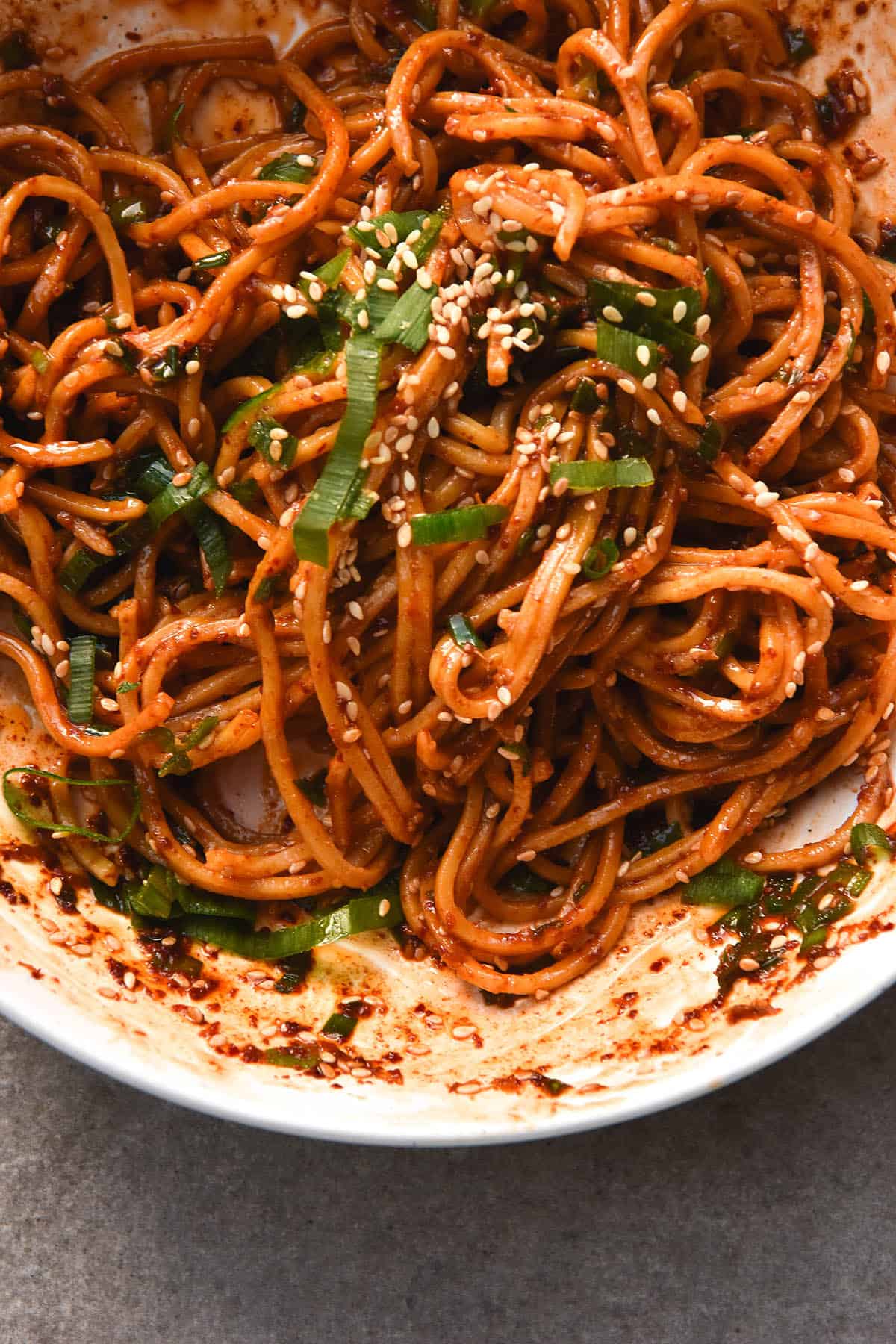
Recipe tips for your low FODMAP chilli oil noodles
The aim of the sauce is to have the oil hot enough that is sizzles on impact and melds the flavours. I find there is less risk of burning the chilli flakes here than when making chilli oil. Because there are other ingredients in the bowl (like spring onion greens) it lessens the burny impact. That said, the oil really only needs a minute to get screaming hot (particularly on a gas stove).
Regular chilli flakes will create a muddier coloured sauce than Korean chilli flakes. The colour won’t affect the flavour, of course. That said, they’re also spicier so make sure you add them to taste.

To make chilli oil roasted potatoes
- Boil 1kg of starchy/floury potatoes in well salted water until soft and preheat the oven to 200C/400F.
- Cut the boiled potatoes into bite sized pieces and arrange them on a tray. Drizzle over 2 tablespoons of vegetable oil and rub it evenly into the potatoes.
- Bake for 30-45 minutes or until crispy and golden.
- Make a double batch of the chilli oil, using 4 tablespoons of oil instead of 5.
- Once the potatoes are crispy, pour over the chilli oil and toss to coat. Sprinkle with extra spring onion greens and toasted sesame seeds and serve immediately.
More low FODMAP vegetarian recipes
- Sweet and sticky buckwheat noodles
- Low FODMAP vegan Pad Thai
- Low FODMAP peanut butter stir fry noodles
- The gluten free egg noodles and ramen from Intolerance Friendly Kitchen
- Buckwheat flour dumpling wrappers from my buckwheat e-book
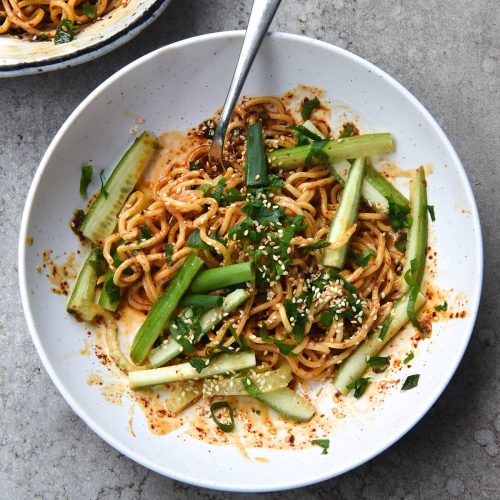
FODMAP friendly chilli oil noodles
Ingredients
- 2 teaspoons Korean chilli flakes see notes and body of post
- 1 teaspoon freshly grated ginger
- 1-2 tablespoons spring onion greens finely chopped
- 2 teaspoons toasted sesame seeds
- 1-2 teaspoons garlic chives optional finely chopped
- Crushed Sichuan pepper or cracked black pepper according to your tastes
- 2 1/2 tablespoons (50ml) vegetable peanut or toasted sesame oil (see notes)
- 1 – 1 1/2 tablespoons (20-30ml) gluten free dark soy sauce see notes
- 1 teaspoon (20ml) honey or maple syrup
- 1 teaspoon black rice vinegar see notes
- 2 teaspoons smooth natural peanut butter or tahini optional, see notes
- 125-150 g gluten free egg noodles see notes
- Extra spring onion greens to garnish (optional)
- Extra sesame seeds to garnish (optional)
- 1/2 cucumber julienned (optional)
Instructions
- Start the process of cooking your noodles. If you’re using the noodles from the cookbook, they take 2-3 minutes.
- Place the chilli flakes, ginger, spring onion greens, sesame oil, (optional) garlic chives and pepper in a heatproof bowl. Stir them up, then arrange them into a small pile (this makes it easier for the small quantity of oil to interact with all the ingredients).
- In a small saucepan over a medium heat, heat the oil until it’s really hot and shimmering. Pour this hot oil over the chilli mixture. It should sizzle up and make the oil lovely and fragrant. If you’re using Korean chilli flakes, it should also take on a lovely red colour.
- Add the dark soy sauce, honey or maple and black rice vinegar. Stir to combine, then taste and adjust to your liking.
- If you’re using it, add the peanut butter or tahini and stir to combine.
- Drain your noodles and add them to the chilli sauce. Toss gently to coat, then top with extra spring onion greens, sesame seeds and perhaps a few cucumber batons before eating.
Notes
- 2 teaspoons contain moderate amounts of fructose. If you have no issues with chilli, go ahead and use 2 teaspoons of Korean chilli flakes. If not, you can use regular chili flakes to taste (they are spicier, so go easy) and some paprika for colour. You can also use 1 teaspoon Korean chilli flakes and extra freshly grated ginger to make up the heat. You could also add some Sichuan or regular pepper.
- Garlic chives are available from Asian grocers and add a little bit of garlic flavour to FODMAP dishes. They are optional, though, so no stress if you don’t have any.
- Toasted sesame oil is not generally supposed to be cooked to a high heat as it loses it’s flavour. I find that it is an easy flavour booster, even when cooked, so I use it. Know that isn’t generally how it is used. You can also use 1/2 tablespoon less oil in the sauce and then drizzle some toasted sesame on top for a nice hit.
- I love using gluten free dark soy sauce here for the colour it adds. You can use Tamari if you don’t have dark soy, but use 2-3 teaspoons and see how you like it. Tamari is saltier than dark soy sauce.
- Black rice vinegar has a sweet, almost watered down balsamic vinegar taste without as strong of an acidic tang. It’s a lovely ingredient here and lends just a bit of acid without being overbearing. You can use white rice vinegar if you don’t have it, but I recommend adding 1/2 teaspoon at first and building up if you like it more acidic.
- The peanut butter or Tahini is just an option for a slightly creamier noodle. They taste delicious either way.
- I have used the gluten free egg noodles from my cookbook, Intolerance Friendly Kitchen, for my tests and these photos.

1 Comment